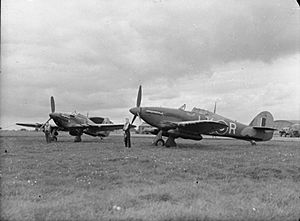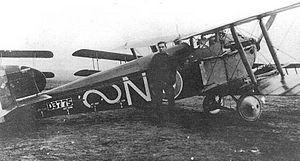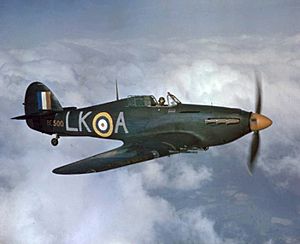No. 87 Squadron RAF facts for kids
Quick facts for kids No. 87 (United Provinces) Squadron RAF |
|
|---|---|
| Active | 1 September 1917 – 24 June 1919 15 March 1937 – 30 December 1946 1 January 1952 – 3 January 1961 |
| Country | |
| Branch | |
| Nickname(s) | United Provinces |
| Motto(s) | Latin: Maximus me metuit ("The most powerful fear me") |
| Insignia | |
| Squadron badge heraldry | A serpent reversed, head reguardant and tail embowed |
| Squadron Roundel |  |
| Squadron codes | PD Oct 1938 – Sep 1939 LK Sep 1939 – Dec 1946 B Jan 1952 – Jan 1961 |
No. 87 Squadron RAF was a special group of aircraft and pilots in the Royal Air Force (RAF). They flew planes during two big wars: World War I and World War II. They also served during the Cold War. This squadron was known for its brave pilots and important missions.
Contents
World War I: The Start of a Squadron
No. 87 Squadron first started on September 1, 1917. It was part of the Royal Flying Corps (RFC) back then. They trained at a place called RAF Upavon. Later, they moved to Hounslow Heath Aerodrome and got cool new planes like the Sopwith Dolphin and S.E.5A.
In April 1918, the squadron moved to France to join the fighting in World War I. After the war ended, the squadron returned to England and was officially stopped on June 24, 1919.
During this time, the squadron had seven "flying aces." An ace is a pilot who has shot down five or more enemy aircraft. Some of these famous aces were Arthur Vigers, Leslie Hollinghurst, and Alexander Pentland. The squadron's special "lazy-S" symbol on their planes was inspired by livestock branding in Texas.
World War II: Fighting for Freedom

No. 87 Squadron was started again on March 15, 1937, at RAF Tangmere. They first flew Hawker Fury planes. When World War II began, the squadron was sent to France. They were equipped with powerful Hawker Hurricanes.
One famous pilot, Ian Gleed, joined the squadron in May 1940. He became an ace in just two days! He later took charge of the squadron in December 1940.
Another important person, John Strachey, who was also a Member of Parliament, worked as the intelligence officer for the squadron during the Battle of Britain.
In July 1944, 87 Squadron joined another group called No. 8 Wing SAAF. They started flying "fighter-bomber" missions in Italy. This meant their planes could both fight enemy aircraft and drop bombs. They also flew missions over the Balkans, helping ground forces. They continued these important missions until the end of the war.
The Cold War: Protecting the Skies
The squadron was formed again on January 1, 1952, in Germany. This was during the Cold War, a time when there was a lot of tension between different countries. No. 87 Squadron's main job was to protect the Ruhr area.
They flew Gloster Meteor NF11 jets. After five years, they moved to RAF Bruggen. There, they got new planes called Gloster Javelins. These were "all-weather interceptor" jets, meaning they could fly in any weather to stop enemy planes. The squadron was finally stopped on January 3, 1961.
Aircraft Flown by 87 Squadron
No. 87 Squadron flew many different types of aircraft throughout its history. Here's a list of the planes they used:
| Dates | Aircraft | Variant | Notes |
|---|---|---|---|
| 1917–1919 | Sopwith Dolphin | Single-engined piston biplane fighter | |
| 1937-1937 | Hawker Fury | II | Single-engined piston biplane fighter |
| 1937–1938 | Gloster Gladiator | I | Single-engined piston biplane fighter |
| 1938–1942 | Hawker Hurricane | I | Single-engined piston monoplane fighter |
| 1941–1944 | Hawker Hurricane | IIC | |
| 1943–1944 | Supermarine Spitfire | IX, VB, VC VIII | Single-engined piston monoplane fighter |
| 1944–1946 | Supermarine Spitfire | IX | |
| 1952–1957 | Gloster Meteor | NF11 | Twin-engined jet night fighter |
| 1957–1961 | Gloster Javelin | FAW1 | Twin-engined all weather and night interceptor |
| 1958–1960 | Gloster Javelin | FAW5 | |
| 1959–1961 | Gloster Javelin | FAW4 |
Notable Pilots
Many brave pilots served in No. 87 Squadron. Here are some of the most well-known:
World War I Pilots
- Charles J.W. Darwin
- Herbert Larkin
- Arthur Vigers
World War II Pilots
Images for kids
-
Blue plaque on Walton House, Northleach, Gloucestershire, remembering its use as billets by pilots of No. 87 Squadron during the Battle of Britain. It shows the squadron's 'serpent' badge.




